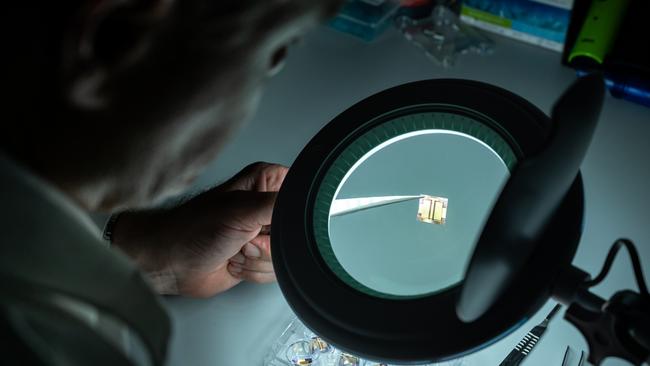The WearOptimo smart patch could help detect a heart attack ahead of time
The cutting-edge Australian technology is planning to expand its health monitoring into an area that could be an everyday lifesaver.

Business
Don't miss out on the headlines from Business. Followed categories will be added to My News.
A cutting-edge patch being developed in Australia has the potential to easily detect heart attacks before they happen.
The wearable sensor, a thin silver sticker around the size of a 10 cent coin, is designed initially to monitor hydration levels for workers on remote mining or high intensity construction sites.
But the ANU-backed tech company WearOptimo is planning to expand its health monitoring into an area that could save lives.
WearOptimo founder and chief executive Mark Kendall says his wearable tech has the potential to help tackle cardiovascular disease and get ahead of heart attacks for timely treatment. This could benefit those people in a high risk category or under significant stress.
“The issue is buying time and getting the warning,” says Dr Kendall who has trained globally as a biomedical engineer.
“What micro-wearables for cardiac application are designed to do is to give you that warning by measuring a key chemical that the heart releases as it starts to undergo a heart attack released into the bloodstream”.
Dr Kendall, who has taught at Harvard University and Oxford University, as well as building a tech spin-off for Oxford, says the initial focus is commercialising his wearable tech as a safety tool to monitor workers operating machinery in high-risk locations including mines and construction sites.
Even small changes in hydration levels can have oversized effects on people. Indeed just a few percentage points drop in hydration can have the same impact as being over the blood alcohol limit which becomes dangerous when heavy trucks and dangerous machinery is being operated in stifling conditions.

“Where we come in with the micro-wearable sensor is we directly measure and investigate your hydration level. So you can get a real time readout of where hydration is sitting and allow you to make a correction on the spot,” Dr Kendall says. “It’s a broad platform deployable in many different areas”.
WearOptimo has just entered into a funding and distribution deal with Canberra healthcare major Aspen Medical, which will see its patches start to be rolled out across the resources sector.
“This deal allows for a significant investment into WearOptimo so that we can further accelerate the development of our first product. And so we’re moving as sensibly and as quickly as we can for that”.
Aspen has been in talks with the mining and energy sectors which have “been crying out for this technology,” he says.
The Brisbane-based WearOptimo is building a smart manufacturing plant with the backing of the Queensland government. When it is fully up and running it will have the capacity to produce as much as 20 million of the micro-patches a year. Full production could see each patch sold for as little as $1 each, giving it an everyday application.
While he had been developing the idea around a monitoring system based on micro research for more than a decade, the launch of the Apple Watch in 2015 gave him additional momentum.

Where the Apple Watch is limited in the information it can receive due to the natural barrier of the skin, the cutting-edge technology behind the micro patches can scan for information below the surface of the skin in a non-invasive way. This allows the patches to gain access to a broad range of health signals and then transmit the encrypted data to the cloud or monitoring platform.
“What we do with our micro-wearable is we use our unique insights into skin physiology. We’ve identified all you have to do is go a hair’s width into the skin. That’s a key sweet spot for all manner of key signals that the body’s producing,” Dr Kendall says.
From the wearer’s point of view it feels like you’re on the very surface of the skin and it’s not penetrating the depth of the skin which means it’s not an implantable device.
Dr Kendall says talks are underway with sports bodies with further applications including elite athletes who can have the patch monitor hydration and other vital signs including real time blood oxygen levels. Eventually the tech will be able to be used in all levels of sport.
“(Athletes) are the most motivated parties that want to be tested on. They’re looking for just that extra half a per cent. And they’re already being monitored and instrumented to the hilt. So they’re already ideal reference points”.
Likewise there are applications in the defence industry for the patch to monitor vital signs for soldiers in the field.
Dr Kendall has been invited to develop his technology in key research centres offshore but he is determined to contribute to Australia’s fast growing technology scene.
“I’ve done the international experience, it was brilliant but I want to do it in Australia, I want to add value to the country”.
“The idea is that for young people you don’t need to go to Oxford to replicate that experience. We want to provide these innovation apprenticeships here”.
Originally published as The WearOptimo smart patch could help detect a heart attack ahead of time



